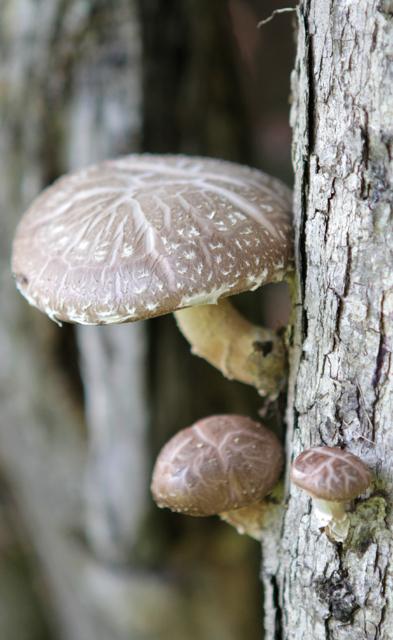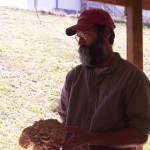- Holy shiitake: Shiitakes fruiting on the log at Ivy Creek Family Farm in Barndardsville. Shiitake season runs April through October, though most of the work to grow shiitakes is happening now by our area farmers. Photo by Nicole Saunders
- The world is his oyster: To help extend his mushroom season, Rodney Webb has experimented with growing oyster mushrooms as well as shiitakes. Photo courtesy of ASAP
It’s official: the trees are completely bare. And that’s just the way our shiitake mushroom farmers like it.
“Shiitake logs must be harvested when the leaves are off and the tree is dormant,” says Paul Littman, who owns and operates Ivy Creek Family Farm in Barnardsville. Littman says that most of the work in growing mushrooms happens from late fall to early spring.
“It’s the kind of work that’ll keep you warm when the weather is cool,” says Rodney Webb of Salamander Springs Gardens in Marshall and the North Carolina Mountain Mushroom Cooperative. “The logs are the heaviest when they’re fresh,” he explains. You have to move them from where they’re cut, to where they’re to be inoculated and then to wherever you plan to stack them for about a year.”
That’s right — a year. That’s because shiitake logs take an average of one full year to begin fruiting harvest-ready mushrooms (fruiting happens from spring to fall). Once a fresh-cut section of, typically oak, tree is harvested, logs of around 40 inches in length are cut, and a series of about 30 to 40 holes are drilled in each log. Littman and Webb, like most mushroom growers, harvest their logs sustainably. The holes are filled with an inoculated sawdust medium, painted over with molten cheese wax or beeswax and stacked in a shady spot. Then, the waiting begins. As farmers, Webb and Littman are used to waiting on crops, although it’s a different experience with mushrooms.
“With our vegetable crops, we see the results of our efforts change daily,” says Littman. “With shiitake logs, these changes take place inside the bark and are impossible to see.” But things are happening, thanks to what he calls “miracle mycelium.”
“The groundwork, or rather ‘under-groundwork’, is being laid days and years in advance of when a mushroom pops up,” Webb says, referencing the mycelium, or the actual fungal organism of the mushroom. “The mushroom,” he clarifies, “is the reproductive part, full of spores, ready to be released when conditions are right.” In that way, Webb finds similarities to his other crops. “Think of the mushrooms as fruit on the tree.”
Mushroom growers and lovers alike agree that there’s also something miraculous about the “fruit” itself. Shiitakes are extremely high in protein, and are believed to have many immune-boosting and cancer-fighting properties.
Webb actually began growing shiitakes after his wife was diagnosed with Hodgkin’s lymphoma in 1997. “We began practicing macrobiotics, and shiitake mushrooms became a regular part of our diet,” he says. But the mushrooms they were eating were imported from Japan or China — hardly local. So, he gave growing them himself a go in the spring of 1998.
Since then, Webb has learned a lot about mushroom cultivation. He manages his logs in a way that ensures he’s no longer dependent on the timing of natural flushes, or when the mushrooms actually pop up. He can force the flushes, which guarantees him a steady supply of shiitakes over the season.
That’s a great thing for him and the other NCMMC growers. Webb and fellow Madison County farmer Glenn Esterson formed the mushroom-growing co-op in the spring of 2008 after noticing all the area’s mushroom producers were knocking on the same doors at the same times. Now, in a partnership with Madison Family Farms, the co-op fills orders from restaurants and grocers each week, thanks to its six regular member-producers — a group that can often grow larger. Madison Family Farms assists NCMMC with their marketing, packaging and delivery, which has helped the co-op quickly become a brand in its own right.
NCMMC has big plans for the future. They’ve recently received a U.S. Forest Service Recovery Act grant geared toward cultivating local underutilized forest products. The grant will help them have access to trees cut down during logging or forest-thinning jobs. It will also help co-op farmers experiment with growing oyster mushrooms on invasive exotic plants and sawmill byproducts.
According to Webb, Pennsylvania supplies 90 percent of all the mushrooms in the entire country. “We have vast amounts of forest resource byproducts here,” he says. “It make sense to get this protein source locally.”
As with other fruits and veggies, local mushrooms stand out. “Most ‘trucked-in’ mushrooms are mass-produced and grown on sterilized sawdust mediums inside warehouses,” Littman says. “Shiitakes grow naturally on logs are a more robust mushroom in every sense — from flavor to nutrition to freshness.”
Just as Littman and Webb do, you’ll have to wait to enjoy their flavor. The main shiitake season runs April to October. Webb and other growers are working to offer oyster mushrooms as a growing season extension, and to utilize some indoor production. Once spring arrives, look for local shiitakes at tailgate markets (Littman sells his at the Weaverville and North Asheville markets), on the menus of area restaurants and on the shelves of the French Broad Food Co-op and other groceries. As our farmers assure you, they’re worth the wait.
Think spring and search Appalachian Sustainable Agriculture Project’s online Local Food Guide by product for all the locations offering up local shiitakes and other mushroom varieties. You can even search by keyword to find farmers growing your favorite type.
To learn more about the NCMMC, visit ncmountainmushroom.com. Rodney Webb and Salamander Springs Gardens can be reached at 380-3150 or salamandersprings@gmail.com. Paul Littman and Anna and Paul’s Farm can be reached at 828-712-4644 or wncfarm@gmail.com.
— Maggie Cramer is the communications coordinator at ASAP(asapconnections.org). Contact her at�maggie@asapconnections.org.






Before you comment
The comments section is here to provide a platform for civil dialogue on the issues we face together as a local community. Xpress is committed to offering this platform for all voices, but when the tone of the discussion gets nasty or strays off topic, we believe many people choose not to participate. Xpress editors are determined to moderate comments to ensure a constructive interchange is maintained. All comments judged not to be in keeping with the spirit of civil discourse will be removed and repeat violators will be banned. See here for our terms of service. Thank you for being part of this effort to promote respectful discussion.